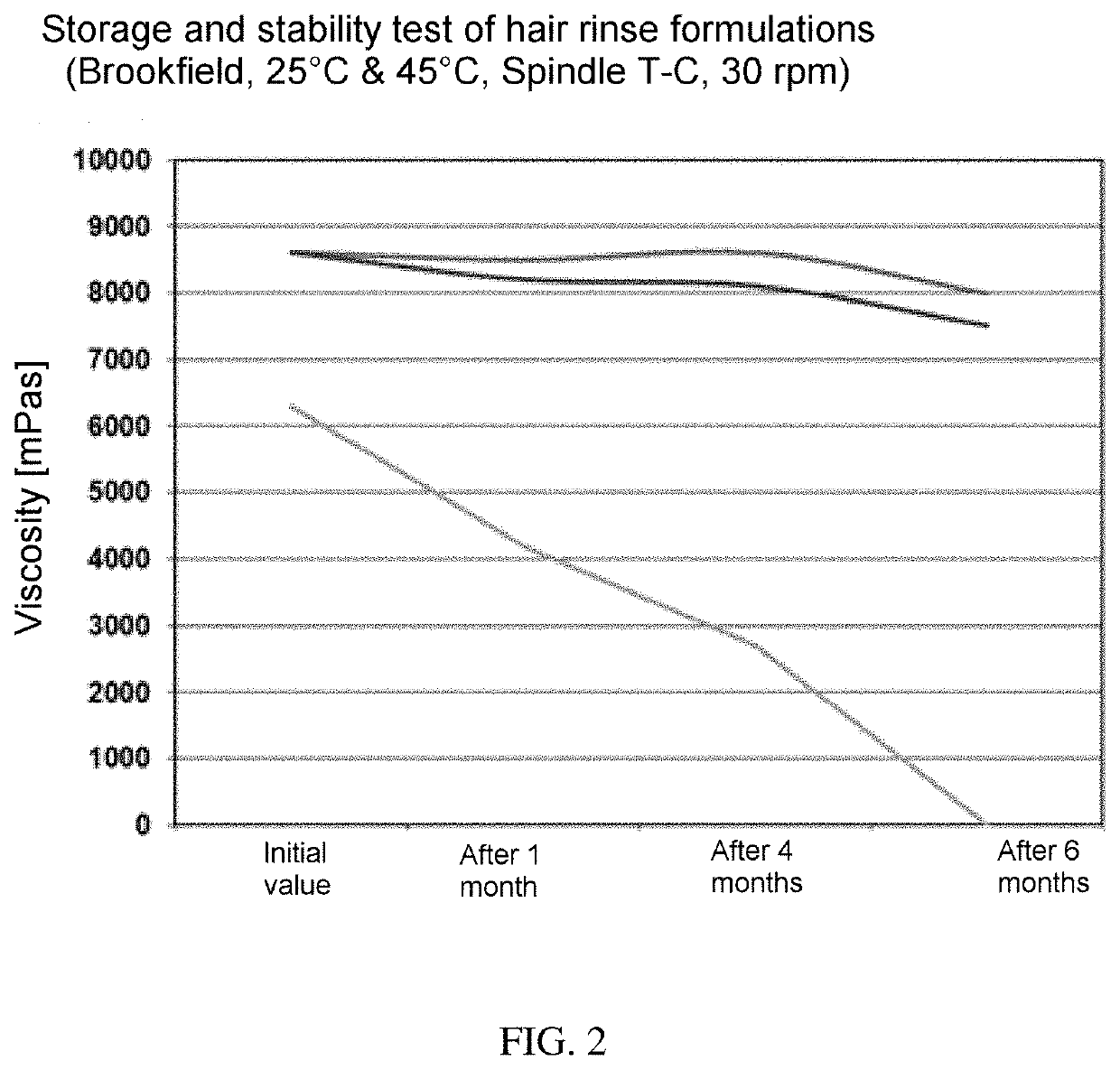Formulation comprising ester quats based on isopropanolamine and tetrahydroxypropyl ethylenediamine
a technology of tetrahydroxypropylethylenediamine and ester quats, which is applied in the field of cosmetic formulations, can solve the problems of limiting the degree of freedom of formulation options, and achieve the effects of improving the shine of the treated keratin fibre, good effect, and easy incorporation into the final consumer formulation
- Summary
- Abstract
- Description
- Claims
- Application Information
AI Technical Summary
Benefits of technology
Problems solved by technology
Method used
Image
Examples
synthesis example 1
Preparation of “1-Propanaminium, 2-Hydroxy-N-(2-Hydroxypropyl)-N-Ethyl-N-Methyl, Diester with Mixed Plant Oil Fatty Acid, Ethyl Sulphate” (According to the Invention)
[0101]560 g (2 mol) of mixed plant oil fatty acid were mixed with 150 g (1.02 mol) of methyldiisopropanolamine and heated to 180° C. with stirring. Water of reaction was distilled off continuously. After the majority of water of reaction had been distilled at atmospheric pressure, vacuum was applied and the acid number of the reaction mixture was reacted down to <7 mg KOH / g. The resulting ester amine was cooled to 60° C. and admixed in portions with 146 g (0.95 mol) of diethyl sulphate, such that the reaction temperature did not exceed 100° C.
[0102]After cooling to room temperature, the total amine number (TAN) and the active content of the finished product were analysed.
[0103]TAN=5.0 mg KOH / g; active content 1.25 meq / g (cationic active content according to Epton).
example 2
Preparation of “1-Propanaminium, 2-Hydroxy-N-(2-Hydroxypropyl)-N,N-Dimethyl, Diester with Palm Fatty Acid, Methyl Sulphate” (not According to the Invention)
[0104]1020 g (4 mol) of palmitic acid (technical-grade quality, approx. 98% pure) were admixed with 302 g (2.05 mol) of methyldiisopropanolamine and esterified as described in Example 1. The ester amine had an acid number of 5.6 mg KOH / g. This mixture was alkylated with 240 g (1.90 mol) of dimethyl sulphate as described in Example 1.
[0105]The TAN of the finished product was determined with 4.8 mg KOH / g, the active content was 1.33 meq / g.
synthesis example 3a
N,N,N′,N′-Tetrakis (2-Hydroxypropyl)Ethylenediaminium, Tetraester with Plant Mixed Oil Fatty Acid, Methyl Sulphate (According to the Invention)
[0106]910.7 g (3.24 mol) of plant mixed oil fatty acid were mixed with 249.4 g (0.85 mol) of N,N,N′,N′-tetrakis (2-hydroxypropyl)ethylenediamine and heated to 180° C. with stirring. Water of reaction was distilled off continuously. After the majority of water of reaction had been distilled at atmospheric pressure, vacuum was applied and the acid number of the reaction mixture was reacted down to <7 mg KOH / g. The resulting ester amine was cooled to 60° C. and admixed in portions with 107.2 g (0.85 mol) of dimethyl sulphate, such that the reaction temperature was maintained in the range of 60-90° C. After cooling to room temperature, the total amine number (TAN) and the active content of the finished product were analysed.
[0107]TAN=40.1 mg KOH / g; active content 0.71 meq / g (cationic active content according to Epton).
PUM
| Property | Measurement | Unit |
|---|---|---|
| weight ratio | aaaaa | aaaaa |
| temperature | aaaaa | aaaaa |
| temperature | aaaaa | aaaaa |
Abstract
Description
Claims
Application Information
 Login to View More
Login to View More - R&D
- Intellectual Property
- Life Sciences
- Materials
- Tech Scout
- Unparalleled Data Quality
- Higher Quality Content
- 60% Fewer Hallucinations
Browse by: Latest US Patents, China's latest patents, Technical Efficacy Thesaurus, Application Domain, Technology Topic, Popular Technical Reports.
© 2025 PatSnap. All rights reserved.Legal|Privacy policy|Modern Slavery Act Transparency Statement|Sitemap|About US| Contact US: help@patsnap.com



